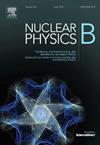U(1)XSSM中的一个95gev希格斯玻色子
IF 2.8
3区 物理与天体物理
Q2 PHYSICS, PARTICLES & FIELDS
引用次数: 0
摘要
CMS和ATLAS合作项目最近报告了他们基于综合运行2数据集的发现,详细介绍了他们对质量约为95 GeV的轻希格斯玻色子的搜索。我们研究了在最小超对称标准模型(U(1)XSSM)的U(1)X扩展中观测到的γγ和bb¯数据在大约95 GeV处的过度。此外,它还会与类标准粒子希格斯玻色子混合。研究表明,在这个模型中,将希格斯单线态的混合物确定为最轻的希格斯玻色子,对于解释观测到的大约95 GeV的过剩具有巨大的潜力。在我们的计算中,我们将最轻的希格斯玻色子和次轻的希格斯玻色子的质量分别保持在大约95 GeV和125 GeV。研究发现,对U(1)XSSM中信号强度μ(h95)γγ和μ(h95)bb¯的理论预测与CMS观测到的过度值吻合得很好。本文章由计算机程序翻译,如有差异,请以英文原文为准。
A 95 GeV Higgs boson in the U(1)XSSM
The CMS and ATLAS Collaborations have recently reported their findings based on the comprehensive run 2 dataset, detailing their searches for a light Higgs boson with a mass of approximately 95 GeV. We investigate the excesses observed in the γγ and data at approximately 95 GeV in the extension of the minimal supersymmetric standard model (SSM). Additionally, it also mixes with the SM-like Higgs boson. Research indicates that, in this model, identifying the mixture of the singlet Higgs states as the lightest Higgs boson holds tremendous potential for explaining the excess observed at approximately 95 GeV. In our calculations, we maintain the masses of the lightest and next-to-lightest Higgs bosons at approximately 95 GeV and 125 GeV, respectively. The study finds that the theoretical predictions for the signal strengths and in the SSM align well with the excesses observed by CMS.
求助全文
通过发布文献求助,成功后即可免费获取论文全文。
去求助
来源期刊

Nuclear Physics B
物理-物理:粒子与场物理
CiteScore
5.50
自引率
7.10%
发文量
302
审稿时长
1 months
期刊介绍:
Nuclear Physics B focuses on the domain of high energy physics, quantum field theory, statistical systems, and mathematical physics, and includes four main sections: high energy physics - phenomenology, high energy physics - theory, high energy physics - experiment, and quantum field theory, statistical systems, and mathematical physics. The emphasis is on original research papers (Frontiers Articles or Full Length Articles), but Review Articles are also welcome.
 求助内容:
求助内容: 应助结果提醒方式:
应助结果提醒方式:


